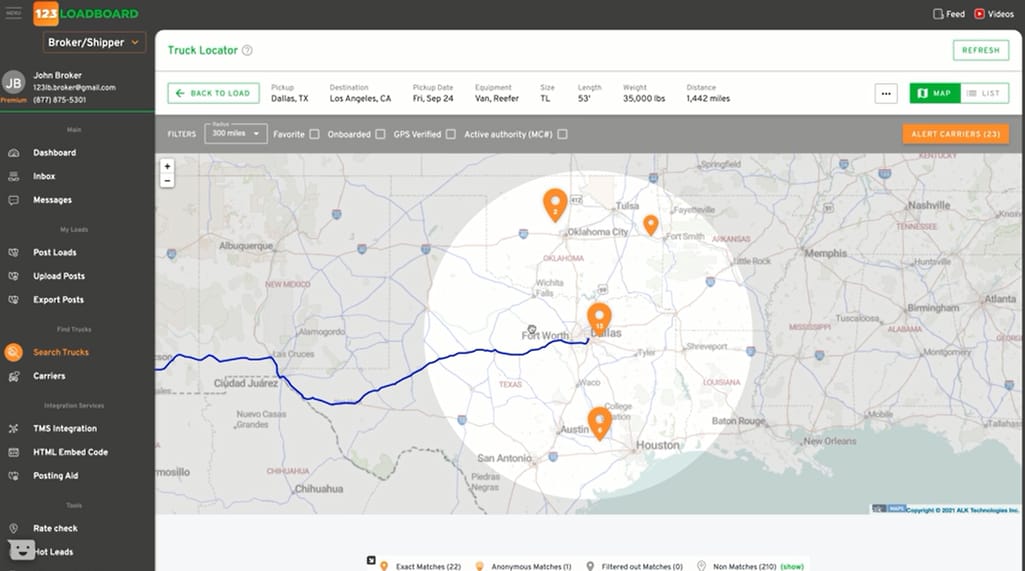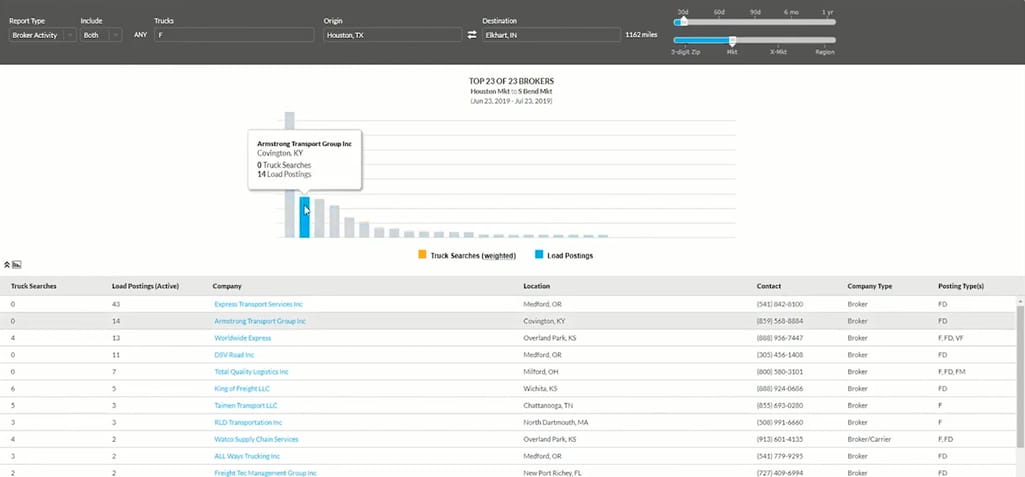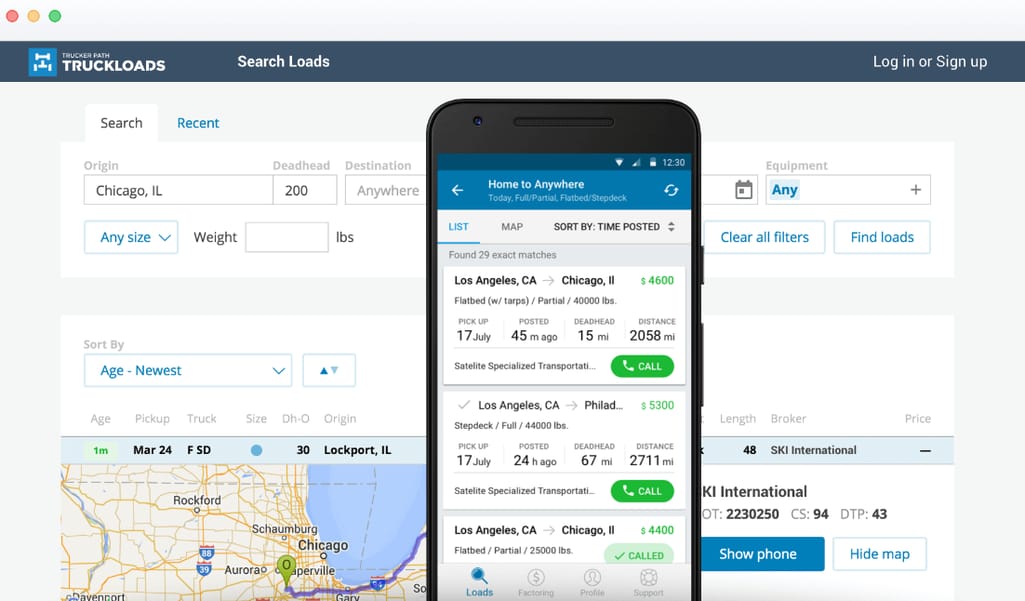Marketplaces have been around for thousands of years. They serve as hubs that connect buyers and sellers, enabling trade and goods/services exchange, and are inexhaustible sources of local information. Today, a big part of these activities moved from traditional downtown bazaars to the Internet – to digital marketplaces of a variety of specialties, from retail to cars to antiques to health insurance, you name it.
In this article, we’ll wander around the digital bazaars of the trucking industry – the load boards, explore how they work, find out what their benefits are, and compare the biggest ones.
What is a load board?
Load boards are online platforms that connect shippers/brokers who have loads and want to move them with available carriers who are looking for freight to carry. Such type of freight marketplaces is a handy tool that keeps freight moving, saving time for all parties involved. They also serve as a source of valuable industry stats and data, e.g., spot rates, lane density, etc.
There are two main groups of load board users — brokers and carriers, so we’ll describe how it works for both. We don’t really mention shippers here as they rarely use load boards: They either have contracted, dedicated carriers; or operate their own, in-house fleets; or entrust brokers to move loads on their behalf. So, the most common load board scenario is the broker-carrier interaction (though, of course, shippers can relate to the broker part as well).
How load boards work for brokers and carriers
How do load boards work for brokers/shippers?
Brokers use load boards in several ways with the key purposes of setting optimal rates and finding trucks to move the loads.
Establishing rates. When brokers get loads from shippers, they have to set up the rates for specific lanes. In other words, brokers and shippers should agree on the price of moving freight. These rates mainly depend on the lane density, i.e., how many trucks are available in that lane and willing to haul cargo. But how can a broker know this capacity and set the right rate for a particular lane?
Besides experience and gut feeling, a good assistant would be a load board. Most platforms have a rate sourcing tool where average market prices for specific lanes are shown. So, it can be a great starting point for establishing rates to give to shippers (with a broker margin included, of course) and negotiating with carriers.
Searching for trucks. To move loads, brokers have to find carriers somehow, right? Instead of asking around at truck stops if there’s anyone available, they use load boards. Indicate the origin and destination, trailer type, and cargo weight – and voila, you’ll get a list (or map view) of trucks that happen to be somewhere near the pickup point and can be contracted to haul that stuff.
Searching for trucks on DAT
Besides, that’s the best way to see the lane density, which, as we said, is important for rate establishment (and sometimes for getting prepared for tough negotiations).
Posting loads. If a broker has a lot of loads to cover (or is just a bit too lazy to do the boring truck search), he or she can post them on the board. This way, carriers will see available loads on the board and respond to know more, try to get a better rate, and, hopefully, take the job. We’ll describe the posting process in more detail later on; meanwhile, let’s explore how it looks from the other side.
How do load boards work for carriers?
Both large fleet owners and owner-operators want their trucks moving, so they rely on load boards for employment. The idea is the same: Instead of annoying shippers with cold calls, carriers open the load board and go through the list of loads that fit their requirements (trailer type, pickup location, maximum weight, etc.). This way, carriers get access to thousands of loads, being able to choose optimal freight, get the best rates, and minimize empty miles.
DAT load list
Other ways carriers benefit from load boards are by consulting the rating tool to get more negotiating power and posting their trucks so that brokers can find them themselves.
Okay, now that we covered the basics, let’s dig deeper into load board functionality.
Main features of load boards
Before we compare the trucking world's most popular load boards, we’ll briefly describe the features that are common to most of them. Please note that functionality differs slightly across providers – and differs greatly across pricing plans.
Loads posting and management
Probably the most important feature for brokers is load posting. To have your load on the list, you’ll have to indicate such details as
- pickup date,
- pickup and drop off points,
- required trailer type (van, reefer, flatbed, step deck, power only, etc.),
- cargo weight,
- additional stops (if any),
- full/LTL load (optional),
- commodity (optional),
- rate (optional),
- dimensions (optional),
- any additional information like hazmat/oversize/military load, required tarping, port entry, pickup or dropoff appointment time, and so on.
Obviously, posted loads also contain the broker’s company name and contact information.
The more details are included in the listing, the easier it is for carriers to know if the load works for them. It also saves time for a broker who won’t have to explain the details over the phone again and again.
Tip: Carriers are typically more willing to call on loads that indicate the exact weight, dimensions, and rate.
Brokers can edit their entries, unpost/deactivate them without deleting, roll them over to the next day, and copy them in case they have multiple similar loads. They can also see the market spot rate to compare it to their own.
Tip: Loads have to be periodically refreshed so that they appear on top of the list for carriers to find them easily without getting lost among thousands of other options.
In addition, load boards allow brokers to manage their preferred carriers list, allowing only trusted partners to view and book the loads. Some platforms also show brokers which carriers have seen their listings.
To expedite and facilitate load posting, brokers integrate their transportation management system with a load board. We’ll talk more about it in one of the next sections.
Truck search and map view
When brokers look for trucks, they get a list of carriers that match the indicated load criteria. They can search either for drivers who want to do a specific lane or for carriers in a particular area around the pickup point. Load boards provide a map view to visualize how close trucks are to the given location.
123LoadBoard Truck Locator tool
Some load boards also allow brokers to send a short message with load details and contact info to nearby matching carriers, alerting them of available freight.
Compliance check
The truck list entries contain the carrier’s information, so brokers can check the public record in the DOT database, review the safety record, inspection summary, and other details, and then decide if the carrier is reliable enough to work with, mitigating unnecessary risks.
Some platforms provide the risk management tools with carrier data integrated from DOT, so that brokers can assess the reliability of potential partners right in the same system.
Truckstop.com’s SaferWatch compliance assessment tool
Load search, comparison, and booking
All load boards have advanced search and filtering capabilities. Carriers can perform unlimited searches to find the right freight. To get a list to choose from, they have to specify the following information:
- date (or time range) of availability,
- pickup point (town, state, or zone),
- destination (town, state, zone, or “anywhere”),
- acceptable deadhead or search radius (how far the driver is willing to travel empty, either to pick up or from drop-off point),
- trailer type,
- full/LTL load, and
- weight/length limit.
The platform filters available loads and makes a list that fits the carrier’s preferences, allowing users to compare options side-by-side and make an informed choice.
Depending on the load board and broker preferences, loads can be either bid on or instantly booked through the platform (which is especially useful after business hours). In other cases, the carrier has to call the broker to book freight over the phone.
Some load boards also allow carriers to search for brokers that offer loads in specific lanes.
DAT LaneMakers tool
Broker credit data
When selecting a load from the list, carriers can see the broker’s contact information and company details. Just like with brokers checking carriers, it’s the same the other way around – before booking freight, carriers want to check their cooperation history (if any) and make sure it’s a reliable broker who pays on time.
Most load board platforms also provide the broker’s credit score, days-to-pay, and other important details for carrier convenience.
Trucker Path’s broker credit summary
Mobile app for carriers
Today, people manage their lives on the run – with smartphones. Truck drivers are no exception; few of them would want (or have a chance) to use an old-fashioned computer while en route. A study by Truckstop.com revealed that over 60 percent of carriers use apps to find loads, 59 percent for checking spot rates, and 58 percent to get paid faster and eliminate paperwork.
So, having a chance to access complete load board functionality, including load booking, setting up alerts about new loads that match recent searches, and documentation exchange, through a user-friendly app is a great advantage for truckers.
Trucker Path desktop and app load search
Market analytics and rate trends
Supply and demand fluctuations impact rates, so it’s crucial to know the current market situation. Load board platforms collect and analyze trucking industry data to allow their users to monitor current trends, average rates, fuel costs, as well as truck-to-load ratio and activity by lane, origin, and destination.
Truckstop.com RateMate tool
All this information allows both brokers and carriers to get an understanding of what’s going on in the market, create a strong negotiating position, and get fair deals.
Mileage calculation, routing, and mapping data
The first thing many experienced truck drivers do when choosing a load is checking the trip mileage. Accurate calculation is crucial for a number of reasons.
- The final rate depends on the mileage.
- Fuel costs depend on the mileage.
- Trip duration and ETA depend on the mileage (drivers should also consider their available hours of service to know if they can make it on time).
Popular navigation tools like Google Maps or Waze work great for car drivers, but truckers need something more comprehensive to create optimal routes. They need a special tool that knows all the truck-related restrictions like low bridges, sharp U-turns, and all those streets where trucks are not allowed at all.
Today, load boards are relied on for precise mileage calculation and route generation since they consider all truck limitations when planning trips. For example, some of the most popular platforms use data from PC*MILER, the industry-leading mileage calculator. Besides, extensive mapping data helps drivers find truck stops, gas and weigh stations, parking, and other useful sites along the way.
Other features: freight factoring, fuel management, and reviews
As we mentioned above, pricing plans vary greatly and you get what you pay for. Depending on the load board, you might need to pay extra for credit scores, lists of preferred or blocked carriers/brokers, more advanced analytics, and other bells and whistles. Some additional features that would usually come at the extra price are
- freight factoring opportunities (getting a chance to get paid sooner);
- fuel management (seeing fuel prices and estimating IFTA fuel tax);
- access to carriers, brokers, and facility reviews left by other users; and so on.
Now that we’ve discussed the main features, we should talk about another crucial part of working with load boards – integration opportunities.
Load board integration
Nowadays, most brokers and carriers worth their salt use some kind of software to automate their daily operations. And in most cases, it’s some sort of a transportation management system (TMS) that helps handle all the transportation activities from planning to reporting.
Integrating a load board with a TMS is a great way to streamline operations, both for brokers and carriers. Major boards come already integrated with some TMSs, but if you use a custom solution, expect it to be a lengthy and costly project involving experienced IT specialists. However, the result is worth the hassle. Here’s why.
Load board and TMS integration for brokers
We’ve already mentioned that load posting is one of the main types of broker interaction with a load board and that it can be simplified with the help of system integration. Once you connect your TMS to a load board platform, the load list from your platform will be automatically uploaded to the board, filling in all the essential details and saving your precious time.
In addition, integration can allow you to get access to other load board features such as truck search or market analytics – all without leaving your internal system.
Load board and TMS integration for carriers
This part is especially advantageous for fleet owners operating multiple trucks. Connecting a load board to a TMS will allow you to pull available load lists from the board, view them in your own system, match them against your empty trucks, and even book freight if a particular platform supports it.
The same thing about rate tools, industry insights, routing, and other features – having a load board integrated into your IT landscape will get you access to all of its perks.
Ok, so we finally got to exploring what the load board market has to offer in different parts of the world.
Best load boards for trucking in the US
The trucking industry is huge in the US, moving about three-quarters of all transported freight in the country and providing jobs for millions of people.
Since so much cargo has to be moved, no wonder load boards are so widespread. There’s an awful lot of them out there, offering a range of pricing plans and capabilities and making it a tough choice. We can’t decide for you, but we can provide you with their descriptions so that you get a better idea of your options. So here we go.
US load boards comparison
DAT Load Board – an industry leader for any fleet size
DAT Freight & Analytics is North America’s largest, oldest, and most popular load board platform. Currently, it offers two groups of products.
DAT One is a suite of handy tools that includes the core Load Board itself, plus a TMS solution for brokers, freight factoring, load tracking, operating authority, and much more.
DAT IQ is a powerful analytics solution that offers insights on rates, capacity, and so on. It comes with such tools as RateView Analytics, Benchmark Analytics, and Custom Analytics, each of which provides transportation market data and intelligence that help users monitor trends, set competitive rates, generate reports, and make informed strategic decisions.
DAT offers a variety of APIs in their developer portal for different integration needs. It also comes integrated with a number of logistics software providers such as Axele, Tai TMS, AscendTMS, MercuryGate, and many more.
Truckstop.com – best for specialized loads
Truckstop.com is another huge freight marketplace with rich functionality and a large community of users. In addition to freight-matching functionality, it helps negotiate loads with analytics and decision-support tools and find reliable partners with high credit scores. It also offers a cargo insurance program and a payment processing solution.
Truckstop.com developer portal contains APIs for different connectivity purposes. The list of already approved TMS partners includes Axele, Transport Pro, Ally, Port TMS, and Revenova TMS.
Trucker Path Truckloads – best free trucker’s app
Trucker Path is a popular truck navigation app, which offers rich, truck-oriented mapping data, plus dispatch services and a fleet management solution. Its main benefits are that it's free, user-friendly, has a vast user base, and provides the best-of-class, truck-safe routing, creating a convenient toolkit in a single app.
A load board is another handy instrument in this kit. Its basic features such as load posting come for free, while a bunch of add-ons like freight factoring service, tracking, and business intelligence tools are included in paid plans.
Here’s a list of partners that are already connected to Trucker Path. However, since the load board is not the app’s main feature, you can’t integrate this functionality via APIs.
123LoadBoard – best value for money
123LoadBoard’s offerings include freight-matching functionality, a routing tool, a rate calculator, a free mobile app for truckers, a load planner, a quick pay feature, and even a fuel card.
APIs allow users to connect 123LoadBoard’s functionality (post loads, post trucks, search loads, and check rates) to their own system, plus there’s a list of approved and pre-integrated industry partners.
Other load boards
Other popular US load boards with an established network of carriers and brokers include
- FreeFreightSearch – a completely free platform with advanced search options, credit reports, and alerts;
- Direct Freight – a low-cost freight marketplace that sends weather alerts, provides mapping and fuel price data, and enables quick payments;
- Convoy – provides practical facility reviews, enables bidding, and supports shipment tracking;
- NextLOAD – a free load board with preset and custom integration options that offers fuel card and factoring programs; and
- Sylectus Omnitracs – designed for small fleets of 5+ trucks and fully integrated with Omnitracs TMS.
Besides, large 3PL companies like C.H. Robinson are developing advanced IT systems, both for internal management and external communication purposes, and open up access to their freight lists, tendering thousands of loads daily – directly to their approved carriers.
Now, let’s look into the trucking activity in the European Union.
Best freight exchange platforms in Europe
The EU trucking industry figures are comparable to that of the US: Over 3 million drivers are involved in driving 6.2 million trucks to haul about 73 percent of total freight transported by land in Europe. To move all that cargo, European brokers and truckers use freight exchange platforms, which is just a different name for a load board.
The general idea is the same as in the US: connecting freight brokers or freight forwarders on one side and transport companies (often called hauliers in Europe) on the other. However, since the EU consists of so many countries with different regulations, laws, and languages, freight exchange platforms have to support international shipping, streamline paperwork, and facilitate communication. Let’s see how the biggest ones cope with these challenges.
EU freight exchanges comparison
TIMOCOM Freight Exchange
TIMOCOM, headquartered in Germany, is the leading European freight exchange platform, with up to 1 million international vehicle space and load offers uploaded daily by over 147,000 users from across Europe. It allows brokers and forwarders to post loads and search for trucks, while hauliers offer their truck space and search for freight.
It offers a mobile app to access the platform’s functionality, plus a route planning and cost calculation feature, GPS tracking capabilities, an international debt collection service, and a transport barometer to monitor the current market situation. To connect users from different EU countries, TIMOCOM is available in 24 languages and is compliant with security and data protection regulations (GDPR).
TIMOCOM Route Planner
TIMOCOM also offers a Smart Logistics System as a software suite that helps manage all transportation activities. Last but not least, there’s a list of 18 approved partners that are seamlessly integrated with TIMOCOM’s system.
Trans.eu
Trans.eu connects 25,000 carriers, 9,000 forwarders, and 6,000 shippers from all around Europe on one freight exchange platform. In addition to freight matching and rate monitoring capabilities, it enables vehicle tracking via easy integration with its telematics system.
CargoON is the brand’s road transport management system for shippers and retailers to streamline their cooperation with carriers and get full control of the supply chains.
Trans.eu offers a rich suite of APIs for a variety of purposes, supported by well-written, detailed documentation, plus a list of pre-integrated partners.
Teleroute
Teleroute posts 350,000 loads to be seen by 85,000 transport professionals daily. Forwarders can create freight offers, automatically get a list of matching trucks and users who viewed the load, see carrier rating, and get access to a T-Interface compatible with 50+ TMS providers to automate load posting.
To carriers, the platform offers a truck route planner, a cost calculator, a mobile app, and the services of payment guarantee and debt mediation. Uniquely, the Teleroute subscription also grants access to two freight exchange platforms — Wtransnet (specialized in Southern Europe) and 123cargo (specialized in the Romanian market).
What to consider when choosing a load board
Obviously, when you choose a load board to subscribe to (by the way, there’s nothing wrong with joining several at once), the most important factors are pricing, functionality, and the number of potential partners you can reach. In other words, you have to assess and balance your resources on one hand and your needs on the other. In addition to that, here are a few more aspects to think about.
Integration. We can’t overstate the importance and usefulness of automation. If you manage your logistics operations in a TMS and want to streamline your interaction with a load board, check the integration opportunities and whether your TMS provider is on the partners list.
Mobile app. We've already touched on the convenience of mobile access to the load board functionality, so be sure to check if you'll be able to handle your business on the go.
Security. Because data security is a big issue, before jumping in, ensure your information is safe within the system and you don't have to worry about any leakage.
International loads and localization. If you want to haul/offer international freight (whether in North America or Europe), find out the load board's coverage. Localization, or content translation and adjustment to foreign markets, is especially important in the EU where a broker and a carrier often come from different countries; so make sure the platform supports such content adaptation and communication.
Load boards have changed the trucking industry in the last few years, and thousands of companies heavily rely on them to move freight or keep trucks busy. Digital products keep evolving and today their users have access to a great deal of handy features and valuable information, gaining competitive advantage – and boosting profits.

Maria is a curious researcher, passionate about discovering how technologies change the world. She started her career in logistics but has dedicated the last five years to exploring travel tech, large travel businesses, and product management best practices.
Want to write an article for our blog? Read our requirements and guidelines to become a contributor.

